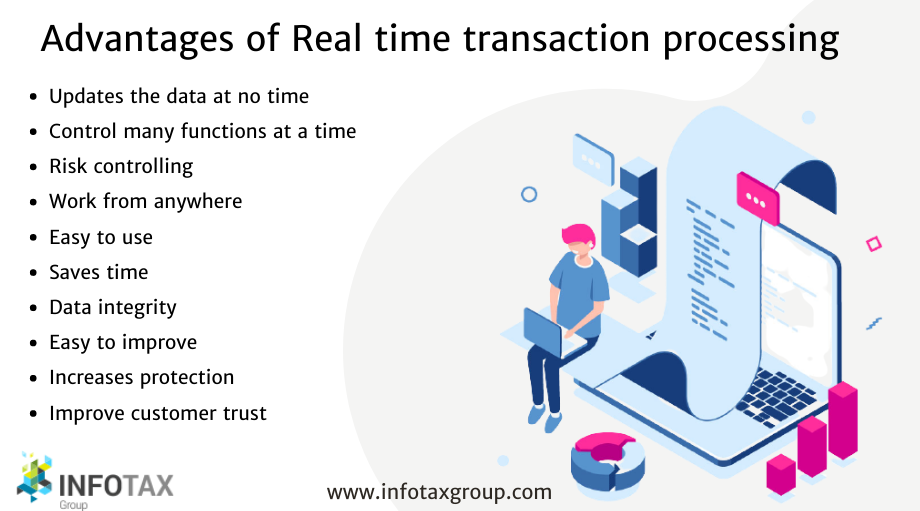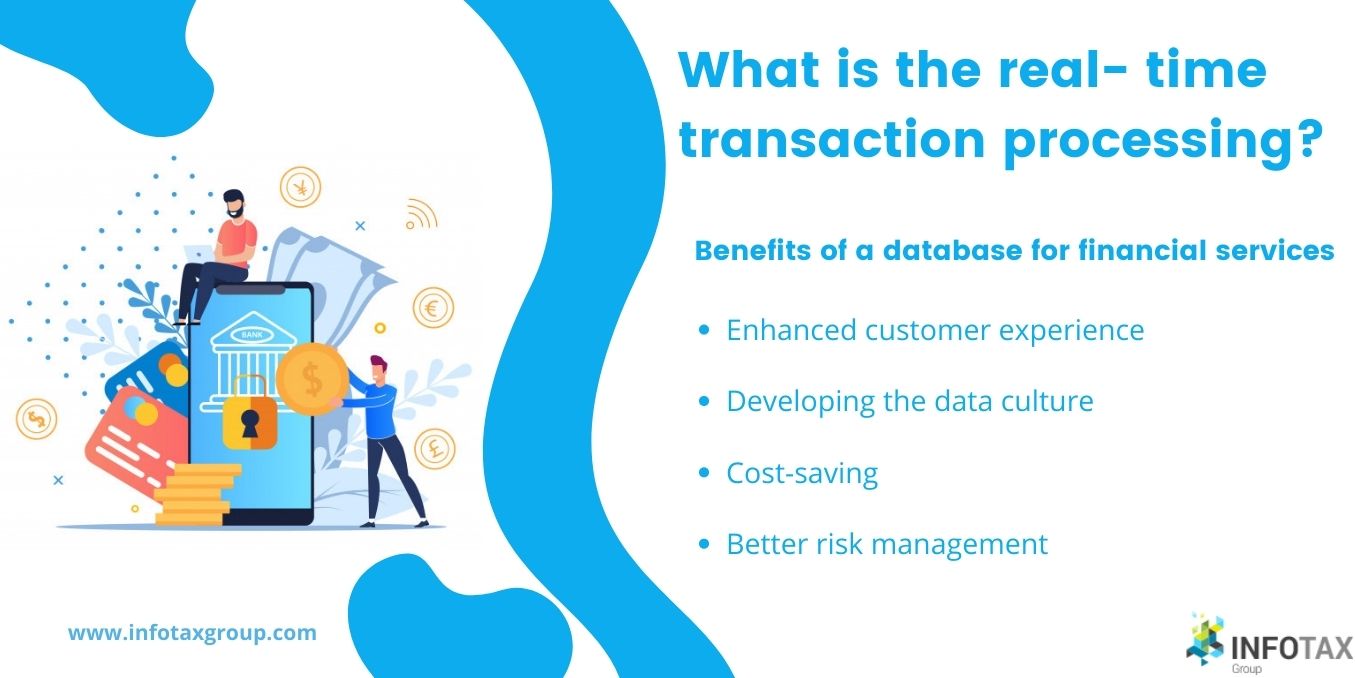The term real time transaction processing is widely used regarding the activity of capturing the details of multiple transactions in real time. Let’s understand through an example- Currently, your bank account balance is Rs. 100,000. You withdrew Rs. 20,000 from your bank account today and at the same time Rs. 50,000 is being deposited in your bank by someone (say your salary being credited). Now, Rs. 20,000 will be debited from your account with the total amount being 80,000 instead of 130,000 if the transactions aren’t captured in real time. Hence, it is vital to capture and record the transaction details between seconds i.e. real-time.
Why do banks need real-time transaction processing?
Banks and other financial institutions are among the fastest-moving markets across the globe. People regard them as a safe place to keep their money. Hence, they need constant information and update regarding their money and whether is it at any risk or not.
Yet these organizations are often under external security threats. They also have redundant internal systems making the data movement across the organization difficult. This lack of speedy data movement makes it hard for the organization to provide cutting-edge tools to the customers as well as equip managers with the required information for quick implementation of best decisions. It also becomes challenging and often impossible to fulfill regulatory compliances, customer demands, and competitive challenges on time.
Banks also need transaction processing due to the requirement of safety-critical systems for processing and handling the massive amount of data related to transaction processing in a systematic and secured manner. Also, the rising need fornon-critical applications based on the conventional database but currently needs to deal with soft “data applications such as IT and multimedia has encouraged banks to transform their transactions processing into real-time.
What is a database?
The database that supports transaction processing is known as a database. Here the term transaction processing means that a transaction is fast enough to deliver the desired result with immediate action upon the same. These activities can include money withdrawal from ATMs, applying for a credit card or a bank loan wherein your data is saved and response is expected within stipulated period, immediately in case of ATM withdrawal. Technically it refers to using AI and machine learning for banking functions. The real time transaction processing focuses on the fresh & official data and enforces time constraints of transactions i.e. constraints on request and its completion.
Benefits of a database for financial services
The databases are majorly requires by the Accounting and Banking functions for multiple reasons.
- Enhanced customer experience- The regular updates provided by database improves customer’s trust intheir financial institution. It also improves the customer’s interaction with its bank including multiple activities such as money withdrawal from ATM, using credit/debit cards, applying for loans, or managing an investment portfolio.
- Developing the data culture- With the help of a database, organizations can manage various things such as compliance with regulations, managing risks, and offering the best customer service and timely support to their customers. However, it cannot be achieves overnight. Any organization will have to implement the data culture across all the functions at various levels. They should also train employees as well as educate their customers through various campaigns-mailers, and messages.
- Cost-saving- Managing a mammoth amount of transaction data is a tough task. Often organizations don’t realize the hidden cost in managing it through traditional processes that often leads to various errors. With the real-time database and transaction processing, companies can do a lot of cost saving.
- Better risk management- It is mandatory for organizations to manage various risks involved in customer portfolios. Shifting to transaction processing helps organizations to manage the risks related to customer portfolios and improves their interaction with customers. This also helps in catering to customer’s expectations and increases their trust the financial institutions.
What kind of database can be real-time?
Various kinds of databases have been used since the early 1960s however there wasn’t any common database in use until the early 1970s. The Relational databases created by E.F. Codd were one of the most commonly uses types of databases. It has popularized the digital organizational tool used by many companies as well as individuals. This revolutionized the way companies communicate and save their data.
Computer systems replaced the traditional way of communication through paper and paper file storage. Similarly, a large amount of information is stores and manages digitally through computer database.
In today’s date, companies are using databases to manage various functions such as accounting, finance, inventory tracking, sales and lead management, and customer relationship management.
processing for managing the constantly
Any database that utilizes processing for managing the constantly changing workloads can be uses as a database. It changes from the traditional databases comprising constant data generated dynamically on time. The stock market is one of the best examples of constantly changing data that is updates dynamically.
Another good example is Firebase which is a type of NoSQL database allowing companies to store and synch data between the users in real-time. Firebase can easily sync the across various types of devices such as iOs, web, and Android without any need of refreshing the screen. Besides,
it offers seamless integration with Google Ads, Data Studio, Slack, Double Click, Big Query, AdMob, and Play Store to ensure your application development is correct and effective.
Flat-file databases are also uses in real-world scenarios. They are generally basic text files that can be utilizes by the local applications for data storage.
However, they are not as popular as rational database integrated with related tables of information wherein each table has a several number of columns and a set of rows. Rational databases are comparatively more popular due to their good performance, scalability, and usage flexibility.

Advantages of Real-time transaction processing:
1. Updates the data at no time: – Real-time TPS updates the data in many databases. As soon as any transaction entered. Thus, it always shows up-to-date data. of the accounts to every customer. There is no waiting time in real-time TPS. Every time when any changes happen in accounts. it updates all databases link to it in no time. For example: if you have given 20,000 to someone’s bank account. Then it adds 20,000 to the bank amount. of that user within seconds. And subtracts 20,000 from your present amount. With this example, we want to say that. one transaction made. needs to make changes in many databases. which the real-time TPS does in a better way. In this system, changes happen so fast. That the user thinks. that it happens in real-time. This is why; it calls a Real-time transaction process system(TPS).
2. Control many functions at a time: – One of the most important qualities of a Real-time TPS. is the power to process many transactions at the same time. And perform so many functions on it. Modern transaction systems can manage. And design or change thousands of sales at the same time. This decreases the company’s toughness level. For the sales process for customers. And provides them big online chances.
3. Risk controlling: – companies need to control many risks. That is connected with the client portfolio. Using this real-time system. Helps companies for controlling risks. That is connected with customer portfolios. and improves customer response. It also helps meet customer needs. And increases trust in financial institutions.
4. Work from anywhere: – Real-time TPS can function from anywhere in the world. This means that place, language. or a barrier to using a transaction processing system. TPS offers more sales work to companies. As it has the benefits of transaction entering from anywhere in the world. This gives the company a large reach. And allows it to reach customers. And win customers all over the world.
5. Easy to use: – Easy to use. And provides easy methods for human communication. And also decreases data entry errors. Its design is so easy to use and work with. And put a stop to mistakes when enters data into it.
6. Saves time: – Saves payment and deal time. mainly for small businesses. that are working with a large number of people. Thus it is very helpful for small businesses. that want to deal with a large number of people.
7. Data integrity: – You can use Real-time TPS in your company. to remove errors in data transactions. As it can continue the same method for all processed transactions. This protects your data from hardware/software errors. and problems.
8. Easy to improve: – TPS hardware and software systems can be improved. without any need to close the company completely. Or no need for a complete rebuild of the full system.
9. Increases protection: – As the process is controllable. Only official persons/employees can access it at a time. Which decreases security problems. that are from third parties. And confirm trouble-free working.
10. Improve customer trust: – Daily database updates increase customer trust in it. It will also increase customer-bank relations. Includes different activities. such as cash taking from ATMs. credit/debit card usage. and loan applications. And also investment portfolio management.
Disadvantages of Real-time transaction processing:
1. Even a few seconds delay can affect a lot: – In Real-time TPS, sometimes it may happen. That a large number of customers make transactions at the same time. This gets tough to work with. It can slow down the process of the full system. Even if the server stops for a few seconds during a sale. Most transactions get problems. That affects your organization’s reputation. This is one of the major disadvantages of real-time TPS.
2. Software and hardware problems: – It can have a problem with the software. and also with the hardware. because the processing system is a set of the two. Thus, virus attacks target personal data. that is stored in databases are very common in these systems. Hardware failure can result in an electrical tragedy. And even can damage the full system.
3. Costly to set up and Install: – As said above, it is a set of software and hardware systems. And also it requires protection systems. for both software and hardware. Thus, it needs information technology systems of good quality. that are high in prizes. Also, the setup. And installation of Real-time processing for the first time takes a high amount of money.
4. Difficult to set up and install: – Due to its difficult structure. it is very tough to set up and install it. For its setup, it needs an expert person. The customer itself cannot set up and install it.
5. Working depends on workplace environment: – It is very focused on entering data. And also in exiting it. also, the calculations are not very correct. And the process is very difficult. It’s working also depends on the type of workplace environment.
6. Many payment systems: – Saves from long waiting lines. By using fast payments systems of many types. And customers can use many ways for payments. like card, cash, mobile payments, etc.
7. Needs to design for organizations: – Real-time TPS needs a special design for the workplace. So that it can fulfill the organization’s needs. It makes it tough to be designed. And adds toughness to it.







